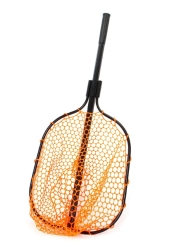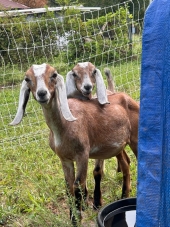




Nina Surya wrote:Thank you all for your helpful messages!
It took this conversation here to convince myself that the gorgeous but misbehaving ram isn't worth the trouble.
I contacted the local sheep farmer and asked him for help. His helper was happy to have my ramming ram, they came to fetch him just a short hour ago.
The ewes are a bit shook after their protector has gone, but luckily they still have eachother and, soon-ish, their lambs.
I'm SO relieved, the farmer was super kind and helpful and his helper shone with joy - everybody happy, except, at this moment, the sheep.
A quick follow-up question that I didn't have the chance (nor the language skills) to ask the farmer: am I being stupid if I'm friendly with the ewes?
I now know better and will not be too friendly with possible male lambs.


Bonnie Johnson wrote:I do not have sheep. I have goats. I have watched videos of adult Rams killing people. These were large rams, over 200 lbs, but I am pretty sure even a smaller ram could injure some one pretty badly. That being said, when ever I have a buck goat even look at me crosswise (like he might even slightly be entertaining going after me) I get either an old wooden handle or a good heavy piece of PVC pipe and when he does it, I whack him right on the end of the nose as hard as I can. I don't hit their forehead or horns, this encourages them to head butt. Usually one strike on the nose is all it takes. They hate it. They will cry and run and shake their head. Their nose is very tender. I have big bucks, one that is almost 200 lbs, one that is slightly over 200 lbs and one that is well over 200 lbs. They also have huge horns as they are mature Kiko bucks. I won't keep a buck that continues to try to come after me as it is too dangerous. However, if you are hesitant to get rid of this ram and I can understand why, you can try hitting him in the nose.
Now, while my bucks don't come after me, they do a lot of damage head butting things. They nearly destroyed their shelter last year. They ruined the fence separating them from the does, again. They head butted down the walls of the does winter shelter and head butted one of the hay feeders into pieces. They then head butted one of those big round wooden spools until it was a bunch of splinters. I am contemplating trying these Ram Shields for when they go into rut. I have not tried them yet. But perhaps they might work for you. Or perhaps you might be able to make one yourself that would work.
https://www.premier1supplies.com/p/ram-shields?cat_id=4
good luck!



Tori Escobar wrote: Elena, thank you so much for your response. You have touched on things that I have been questioning recently. Firstly, I do have a decent shelter for them but I think I will go ahead and shore up the open side once it starts getting chilly.
We’re in southern Oklahoma so it’s barely become fall now.
I am definitely on the side of low input, stalwart and economical animals versus loads of milk. That may change at some point but I’d love to breed the Nubians with a meat breed (Boar) and then select offspring for those traits.
The goats have been doing a pretty good job clearing paddocks and staying in their electric netting surprisingly well. I will say it requires intentionally and more work managing in this rotational manner but I am really pleased with the results already.
I think the hard part is learning to determine if they’re ready to move or if they are being picky. I’ve noticed that they know when something really tasty is in the offing and then refuse to eat the less desirable things. With that in mind, I have allowed them to stay in paddocks longer than before and made them smaller.
I’m getting nervous about winter though because it’s like they will not touch any hay I put in their stall. I’ve tried three different times from local farmers. Any thoughts on hay for the winter?
I check their FAMACHA score every so often and they are looking very good.
When I got them one of the goats under lid was like white. Now it’s very pink so I’m pleased about that. I haven’t wormed them yet but I have some herbal wormer on hand from Mollys herbs.
One of the girls doesn’t like to be touched which concerns me, should I force her to get used to it?
Thanks again for your input! So helpful!!


Denise Cares wrote:
Lif Strand wrote: I know nothing about goats, so let me ask this dumb question. Smoky has big horns in all the photos, even as a lamb. So how long does it take for horns to grow from birth on, and does the growth rate stay the same throughout a goat's life?
Elena, Smoky is a beautiful ram! Especially those horns add to the regal look!
Lif, let me chime in here...a ram and a goat are two different species altho both are ruminant animals. Male Sheep and either male or female goats can have horns. However, they are two separate species with different characteristics and uses. Elena's animals are sheep, not goats...and since I was not well versed on horns for either species I looked it up. I think Elena's sheep are a Merino breed and have those beautiful curved horns (I was reading her post about rooing which is another fascinating topic). Come to find out that some male sheep breeds like Jacob's sheep can re-grow from 2 to 6 horns yearly! Their look is most startling! I had never seen a picture of this much less in real life. Wow! On the other hand, goats (which both the males & females may or may not have horns) and rams loose their horns yearly and regrow them every year. It is another fascinating topic to read up on. So much to learn from the study of animals! Rams' horns get bigger every year for the purpose of defending their herd of ewes and establishing dominance. Here's where I read about rams horns: https://www.berrypatchfarms.net/do-rams-shed-their-horns/. Goats and their horns are a bit more complicated and I read a little about that here: https://rurallivingtoday.com/livestock/goat-horns/. There are many descriptions in Scripture about sheep and goats and so learning about this one aspect helps me to understand the meaning & intent of holy writ also. Great topic and pics on this forum!